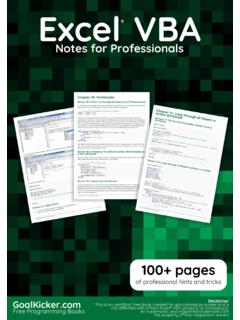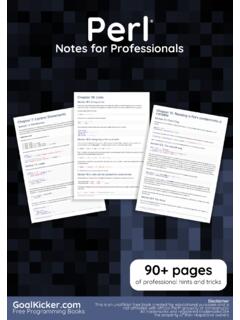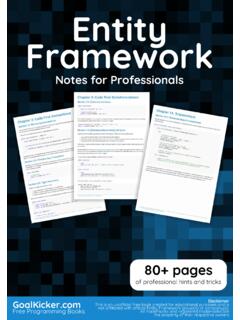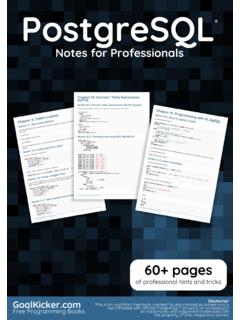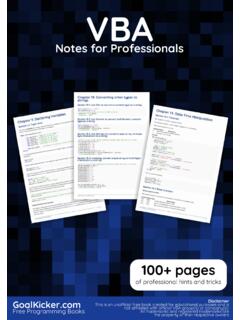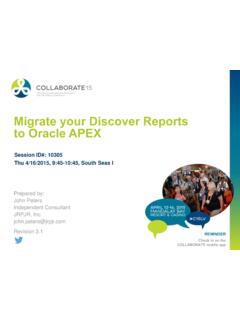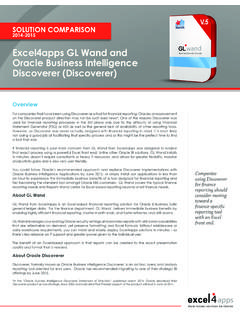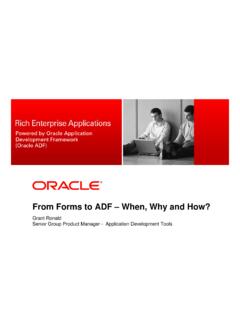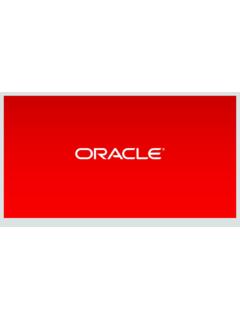Transcription of Oracle Database Notes for Professionals - …
1 Oracle DatabaseNotes for ProfessionalsOracle DatabaseNotes for Programming BooksDisclaimerThis is an uno cial free book created for educational purposes and isnot a liated with o cial Oracle Database group(s) or company(s).All trademarks and registered trademarks arethe property of their respective owners100+ pagesof professional hints and tricksContentsAbout 1 .. Chapter 1: Getting started with Oracle Database 2 .. Section : Hello World 2 .. Section : SQL Query 2 .. Section : Hello world! from table 2 .. Section : Hello World from PL/SQL 3 .. Chapter 2: Getting started with PL/SQL 4 .. Section : Hello World 4 .. Section : Definition of PL/SQL 4 .. Section : Di erence between %TYPE and %ROWTYPE 5 .. Section : Create or replace a view 6 .. Section : Create a table 6 .. Section : About PL/SQL 6 .. Chapter 3: Anonymous PL/SQL Block 8 .. Section : An example of an anonymous block 8 .. Chapter 4: PL/SQL procedure 9 .. Section : Syntax 9.
2 Section : Hello World 9 .. Section : In/Out Parameters 9 .. Chapter 5: Data Dictionary 11 .. Section : Describes all objects in the Database 11 .. Section : To see all the data dictionary views to which you have access 11 .. Section : Text source of the stored objects 11 .. Section : Get list of all tables in Oracle 11 .. Section : Privilege information 11 .. Section : Oracle version 12 .. Chapter 6: Dates 13 .. Section : Date Arithmetic - Di erence between Dates in Days, Hours, Minutes and/or Seconds 13 .. Section : Setting the Default Date Format Model 14 .. Section : Date Arithmetic - Di erence between Dates in Months or Years 14 .. Section : Extract the Year, Month, Day, Hour, Minute or Second Components of a Date 15 .. Section : Generating Dates with No Time Component 16 .. Section : Generating Dates with a Time Component 16 .. Section : The Format of a Date 17 .. Section : Converting Dates to a String 17 .. Section : Changing How SQL/Plus or SQL Developer Display Dates 18.
3 Section : Time Zones and Daylight Savings Time 18 .. Section : Leap Seconds 19 .. Section : Getting the Day of the Week 19 .. Chapter 7: Working with Dates 20 .. Section : Date Arithmetic 20 .. Section : Add_months function 20 .. Chapter 8: DUAL table 22 .. Section : The following example returns the current operating system date and time 22 .. Section : The following example generates numbers between start_value and end_value 22 .. Chapter 9: JOINS 23 .. Section : CROSS JOIN 23 .. Section : LEFT OUTER JOIN 24 .. Section : RIGHT OUTER JOIN 25 .. Section : FULL OUTER JOIN 27 .. Section : ANTIJOIN 28 .. Section : INNER JOIN 29 .. Section : JOIN 30 .. Section : SEMIJOIN 30 .. Section : NATURAL JOIN 31 .. Chapter 10: Handling NULL values 33 .. Section : Operations containing NULL are NULL, except concatenation 33 .. Section : NVL2 to get a di erent result if a value is null or not 33 .. Section : COALESCE to return the first non-NULL value 33.
4 Section : Columns of any data type can contain NULLs 33 .. Section : Empty strings are NULL 33 .. Section : NVL to replace null value 34 .. Chapter 11: String Manipulation 35 .. Section : INITCAP 35 .. Section : Regular expression 35 .. Section : SUBSTR 35 .. Section : Concatenation: Operator || or concat() function 36 .. Section : UPPER 36 .. Section : LOWER 37 .. Section : LTRIM / RTRIM 37 .. Chapter 12: IF-THEN-ELSE Statement 38 .. Section : IF-THEN 38 .. Section : IF-THEN-ELSE 38 .. Section : IF-THEN-ELSIF-ELSE 38 .. Chapter 13: Limiting the rows returned by a query (Pagination) 39 .. Section : Get first N rows with row limiting clause 39 .. Section : Get row N through M from many rows (before Oracle 12c) 39 .. Section : Get N numbers of Records from table 39 .. Section : Skipping some rows then taking some 40 .. Section : Skipping some rows from result 40 .. Section : Pagination in SQL 40 .. Chapter 14: Recursive Sub-Query Factoring using the WITH Clause ( CommonTable Expressions) 42.
5 Section : Splitting a Delimited String 42 .. Section : A Simple Integer Generator 42 .. Chapter 15: Di erent ways to update records 44 .. Section : Update using Merge 44 .. Section : Update Syntax with example 44 .. Section : Update Using Inline View 44 .. Section : Merge with sample data 45 .. Chapter 16: Update with Joins 47 .. Section : Examples: what works and what doesn't 47 .. Chapter 17: Functions 49 .. Section : Calling Functions 49 .. Chapter 18: Statistical functions 50 .. Section : Calculating the median of a set of values 50 .. Chapter 19: Window Functions 51 .. Section : Ratio_To_Report 51 .. Chapter 20: Creating a Context 52 .. Section : Create a Context 52 .. Chapter 21: Splitting Delimited Strings 53 .. Section : Splitting Strings using a Hierarchical Query 53 .. Section : Splitting Strings using a PL/SQL Function 53 .. Section : Splitting Strings using a Recursive Sub-query Factoring Clause 54 .. Section : Splitting Strings using a Correlated Table Expression 55.
6 Section : Splitting Strings using CROSS APPLY ( Oracle 12c) 56 .. Section : Splitting Strings using XMLT able and FLWOR expressions 57 .. Section : Splitting Delimited Strings using XMLT able 57 .. Chapter 22: Collections and Records 59 .. Section : Use a collection as a return type for a split function 59 .. Chapter 23: Object Types 60 .. Section : Accessing stored objects 60 .. Section : BASE_TYPE 60 .. Section : MID_TYPE 61 .. Section : LEAF_TYPE 62 .. Chapter 24: Loop 64 .. Section : Simple Loop 64 .. Section : WHILE Loop 64 .. Section : FOR Loop 64 .. Chapter 25: Cursors 67 .. Section : Parameterized "FOR loop" Cursor 67 .. Section : Implicit "FOR loop" cursor 67 .. Section : Handling a CURSOR 67 .. Section : Working with SYS_REFCURSOR 68 .. Chapter 26: Sequences 69 .. Section : Creating a Sequence: Example 69 .. Chapter 27: Indexes 71 .. Section : b-tree index 71 .. Section : Bitmap Index 71 .. Section : Function Based Index 71.
7 Chapter 28: Hints 72 .. Section : USE_NL 72 .. Section : APPEND HINT 72 .. Section : Parallel Hint 72 .. Section : USE_HASH 73 .. Section : FULL 73 .. Section : Result Cache 74 .. Chapter 29: Packages 75 .. Section : Define a Package header and body with a function 75 .. Section : Overloading 75 .. Section : Package Usage 76 .. Chapter 30: Exception Handling 78 .. Section : Syntax 78 .. Section : User defined exceptions 78 .. Section : Internally defined exceptions 79 .. Section : Predefined exceptions 80 .. Section : Define custom exception, raise it and see where it comes from 81 .. Section : Handling connexion error exceptions 82 .. Section : Exception handling 83 .. Chapter 31: Error logging 84 .. Section : Error logging when writing to Database 84 .. Chapter 32: Database Links 85 .. Section : Creating a Database link 85 .. Section : Create Database Link 85 .. Chapter 33: Table partitioning 87 .. Section : Select existing partitions 87.
8 Section : Drop partition 87 .. Section : Select data from a partition 87 .. Section : Split Partition 87 .. Section : Merge Partitions 87 .. Section : Exchange a partition 87 .. Section : Hash partitioning 88 .. Section : Range partitioning 88 .. Section : List partitioning 88 .. Section : Truncate a partition 89 .. Section : Rename a partition 89 .. Section : Move partition to di erent tablespace 89 .. Section : Add new partition 89 .. Chapter 34: Oracle Advanced Queuing (AQ) 90 .. Section : Simple Producer/Consumer 90 .. Chapter 35: constraints 94 .. Section : Update foreign keys with new value in Oracle 94 .. Section : Disable all related foreign keys in Oracle 94 .. Chapter 36: Autonomous Transactions 95 .. Section : Using autonomous transaction for logging errors 95 .. Chapter 37: Oracle MAF 96 .. Section : To get value from Binding 96 .. Section : To set value to binding 96 .. Section : To invoke a method from binding 96.
9 Section : To call a javaScript function 96 .. Chapter 38: level query 97 .. Section : Generate N Number of records 97 .. Section : Few usages of Level Query 97 .. Chapter 39: Hierarchical Retrieval With Oracle Database 12C 98 .. Section : Using the CONNECT BY Caluse 98 .. Section : Specifying the Direction of the Query From the Top Down 98 .. Chapter 40: Data Pump 99 .. Section : Monitor Datapump jobs 99 .. Section : Step 3/6 : Create directory 99 .. Section : Step 7 : Export Commands 99 .. Section : Step 9 : Import Commands 100 .. Section : Datapump steps 101 .. Section : Copy tables between di erent schemas and tablespaces 101 .. Chapter 41: Bulk collect 102 .. Section : Bulk data Processing 102 .. Chapter 42: Real Application Security 103 .. Section : Application 103 .. Chapter 43: Assignments model and language 105 .. Section : Assignments model in PL/SQL 105 .. Chapter 44: Triggers 107 .. Section : Before INSERT or UPDATE trigger 107.
10 Chapter 45: Dynamic SQL 108 .. Section : Select value with dynamic SQL 108 .. Section : Insert values in dynamic SQL 108 .. Section : Update values in dynamic SQL 108 .. Section : Execute DDL statement 109 .. Section : Execute anonymous block 109 .. Credits 110 .. You may also like 112 .. Oracle Database Notes for Professionals1 AboutPlease feel free to share this PDF with anyone for free,latest version of this book can be downloaded from: Oracle Database Notes for Professionals book is compiled from StackOverflow Documentation, the content is written by the beautiful people at StackOverflow. Text content is released under Creative Commons BY-SA, see credits atthe end of this book whom contributed to the various chapters. Images may becopyright of their respective owners unless otherwise specifiedThis is an unofficial free book created for educational purposes and is notaffiliated with official Oracle Database group(s) or company(s) nor StackOverflow.



